Healthcare Case Study: Promoting Wellbeing and Building Resilience
VerifiedAdded on 2023/06/10
|10
|1990
|322
Case Study
AI Summary
This case study explores the interconnectedness of mental well-being and resilience, identifying six symptoms of stress and examining factors that both improve and negatively impact well-being. It delves into behaviors associated with positive resilience and methods for building it, including self-a...
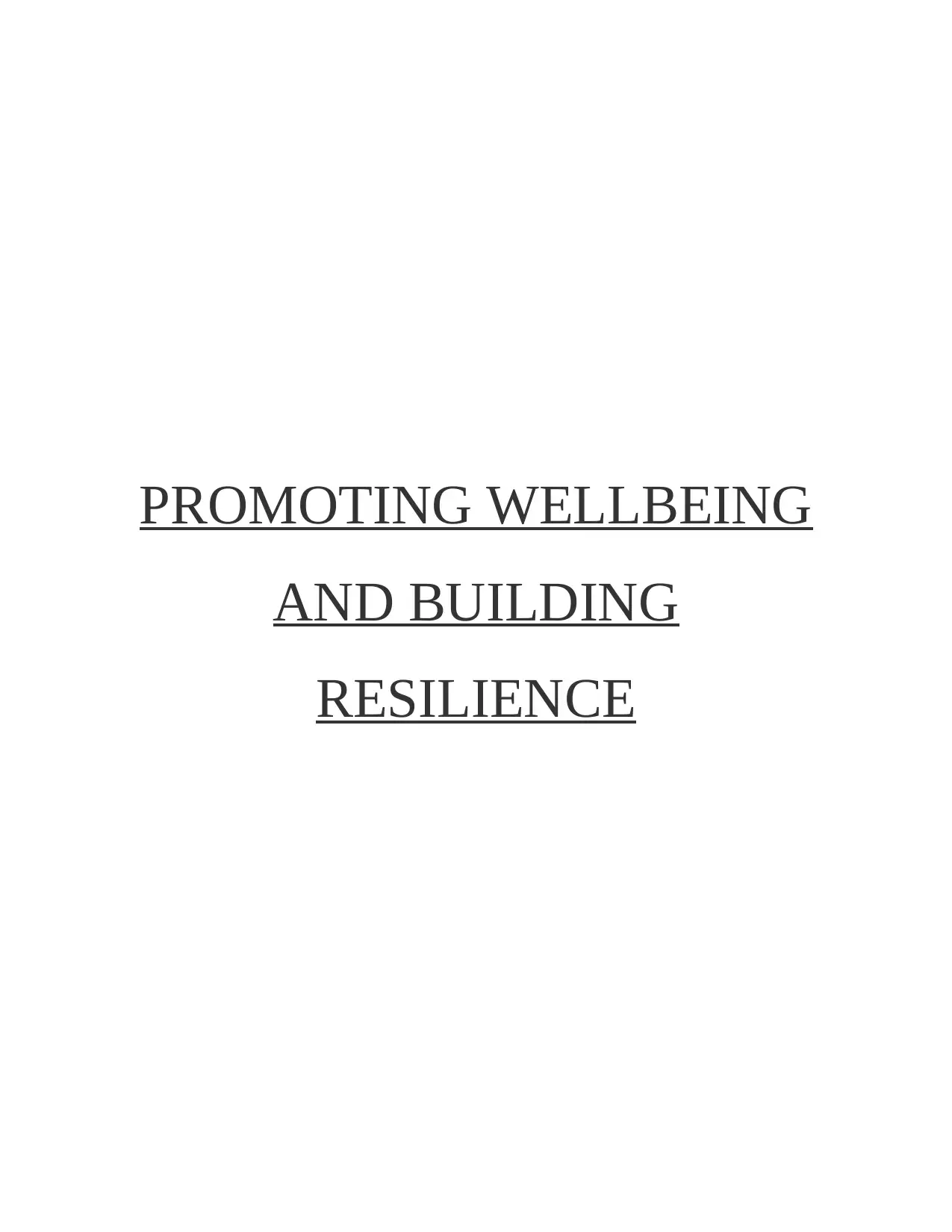
PROMOTING WELLBEING
AND BUILDING
RESILIENCE
AND BUILDING
RESILIENCE
Paraphrase This Document
Need a fresh take? Get an instant paraphrase of this document with our AI Paraphraser
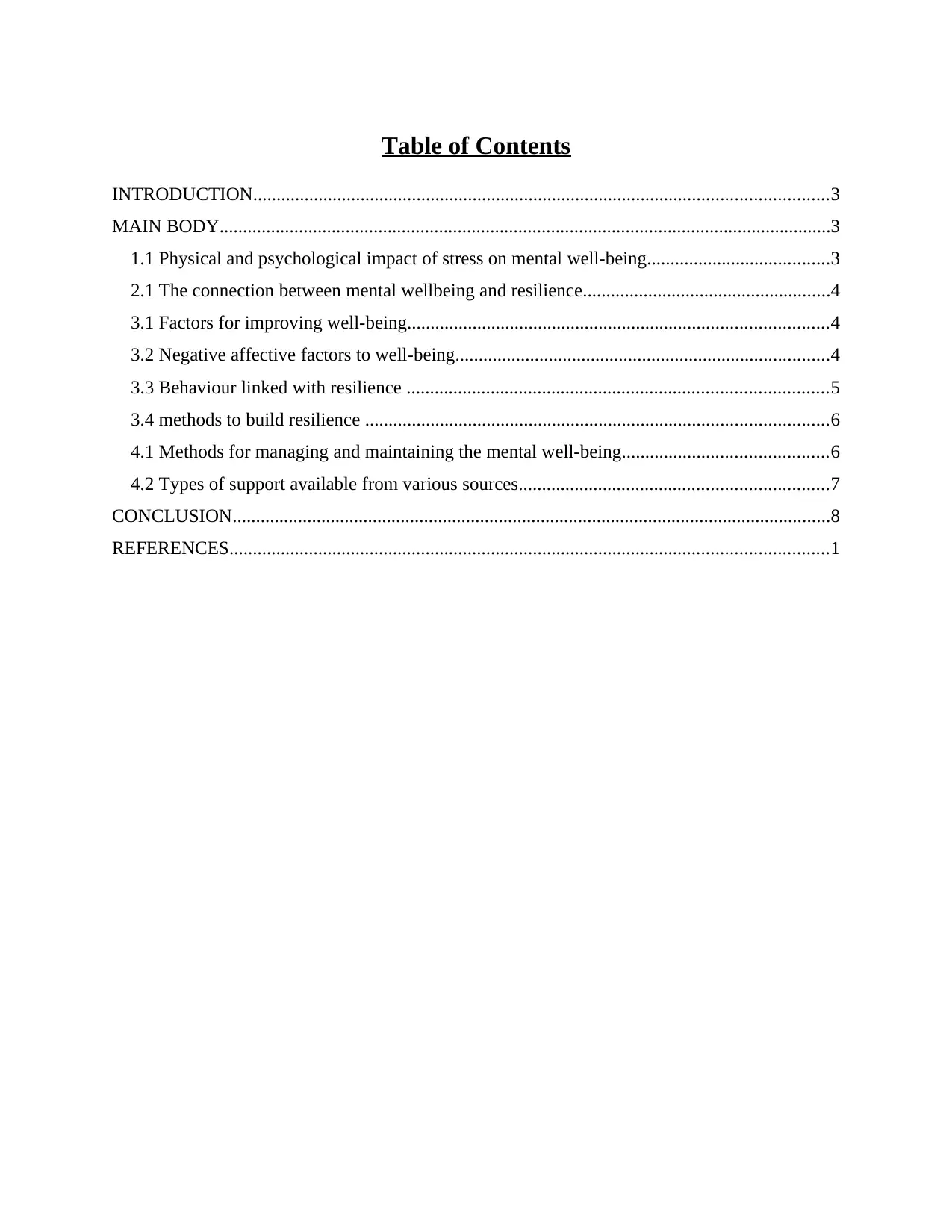
Table of Contents
INTRODUCTION...........................................................................................................................3
MAIN BODY...................................................................................................................................3
1.1 Physical and psychological impact of stress on mental well-being.......................................3
2.1 The connection between mental wellbeing and resilience.....................................................4
3.1 Factors for improving well-being..........................................................................................4
3.2 Negative affective factors to well-being................................................................................4
3.3 Behaviour linked with resilience ..........................................................................................5
3.4 methods to build resilience ...................................................................................................6
4.1 Methods for managing and maintaining the mental well-being............................................6
4.2 Types of support available from various sources..................................................................7
CONCLUSION................................................................................................................................8
REFERENCES................................................................................................................................1
INTRODUCTION...........................................................................................................................3
MAIN BODY...................................................................................................................................3
1.1 Physical and psychological impact of stress on mental well-being.......................................3
2.1 The connection between mental wellbeing and resilience.....................................................4
3.1 Factors for improving well-being..........................................................................................4
3.2 Negative affective factors to well-being................................................................................4
3.3 Behaviour linked with resilience ..........................................................................................5
3.4 methods to build resilience ...................................................................................................6
4.1 Methods for managing and maintaining the mental well-being............................................6
4.2 Types of support available from various sources..................................................................7
CONCLUSION................................................................................................................................8
REFERENCES................................................................................................................................1
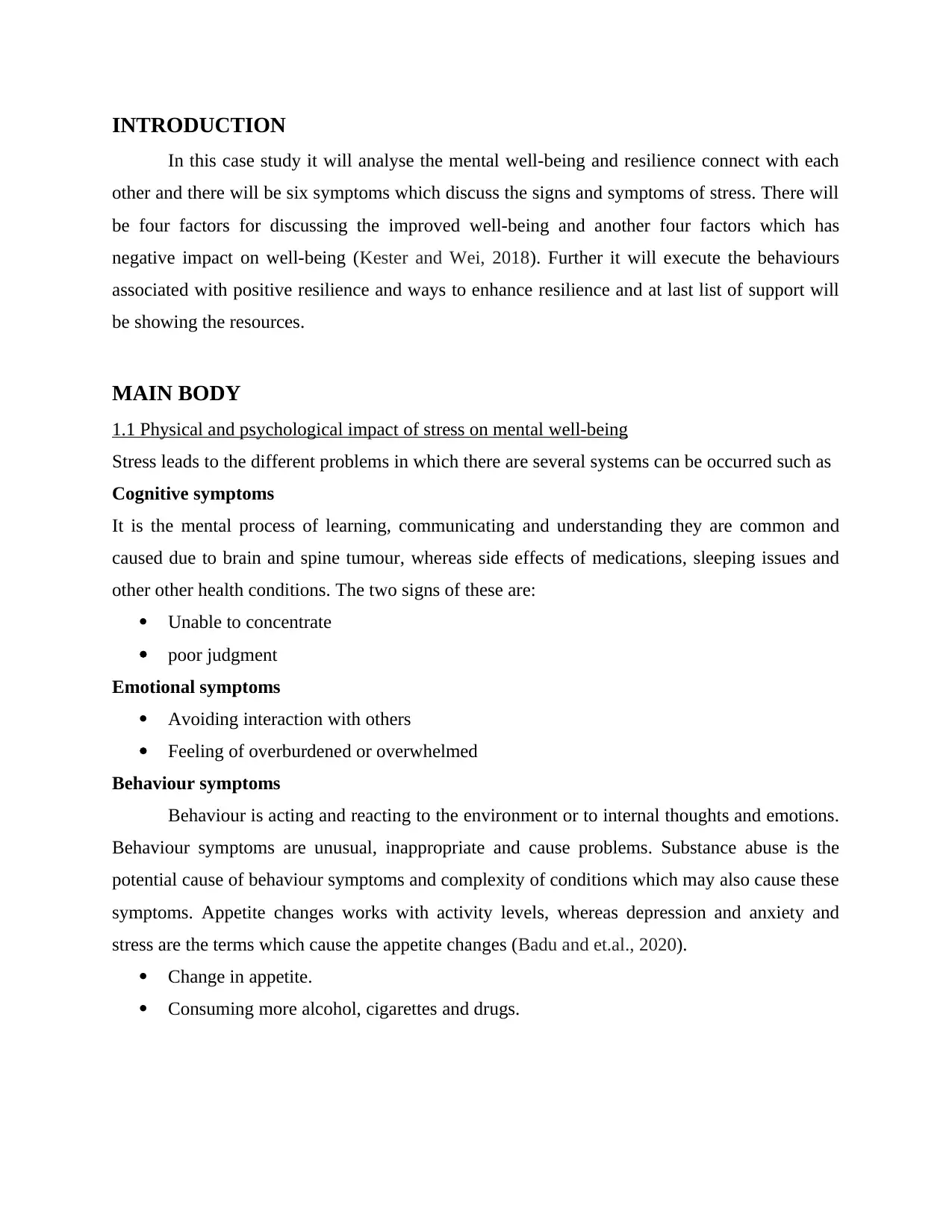
INTRODUCTION
In this case study it will analyse the mental well-being and resilience connect with each
other and there will be six symptoms which discuss the signs and symptoms of stress. There will
be four factors for discussing the improved well-being and another four factors which has
negative impact on well-being (Kester and Wei, 2018). Further it will execute the behaviours
associated with positive resilience and ways to enhance resilience and at last list of support will
be showing the resources.
MAIN BODY
1.1 Physical and psychological impact of stress on mental well-being
Stress leads to the different problems in which there are several systems can be occurred such as
Cognitive symptoms
It is the mental process of learning, communicating and understanding they are common and
caused due to brain and spine tumour, whereas side effects of medications, sleeping issues and
other other health conditions. The two signs of these are:
Unable to concentrate
poor judgment
Emotional symptoms
Avoiding interaction with others
Feeling of overburdened or overwhelmed
Behaviour symptoms
Behaviour is acting and reacting to the environment or to internal thoughts and emotions.
Behaviour symptoms are unusual, inappropriate and cause problems. Substance abuse is the
potential cause of behaviour symptoms and complexity of conditions which may also cause these
symptoms. Appetite changes works with activity levels, whereas depression and anxiety and
stress are the terms which cause the appetite changes (Badu and et.al., 2020).
Change in appetite.
Consuming more alcohol, cigarettes and drugs.
In this case study it will analyse the mental well-being and resilience connect with each
other and there will be six symptoms which discuss the signs and symptoms of stress. There will
be four factors for discussing the improved well-being and another four factors which has
negative impact on well-being (Kester and Wei, 2018). Further it will execute the behaviours
associated with positive resilience and ways to enhance resilience and at last list of support will
be showing the resources.
MAIN BODY
1.1 Physical and psychological impact of stress on mental well-being
Stress leads to the different problems in which there are several systems can be occurred such as
Cognitive symptoms
It is the mental process of learning, communicating and understanding they are common and
caused due to brain and spine tumour, whereas side effects of medications, sleeping issues and
other other health conditions. The two signs of these are:
Unable to concentrate
poor judgment
Emotional symptoms
Avoiding interaction with others
Feeling of overburdened or overwhelmed
Behaviour symptoms
Behaviour is acting and reacting to the environment or to internal thoughts and emotions.
Behaviour symptoms are unusual, inappropriate and cause problems. Substance abuse is the
potential cause of behaviour symptoms and complexity of conditions which may also cause these
symptoms. Appetite changes works with activity levels, whereas depression and anxiety and
stress are the terms which cause the appetite changes (Badu and et.al., 2020).
Change in appetite.
Consuming more alcohol, cigarettes and drugs.
⊘ This is a preview!⊘
Do you want full access?
Subscribe today to unlock all pages.

Trusted by 1+ million students worldwide
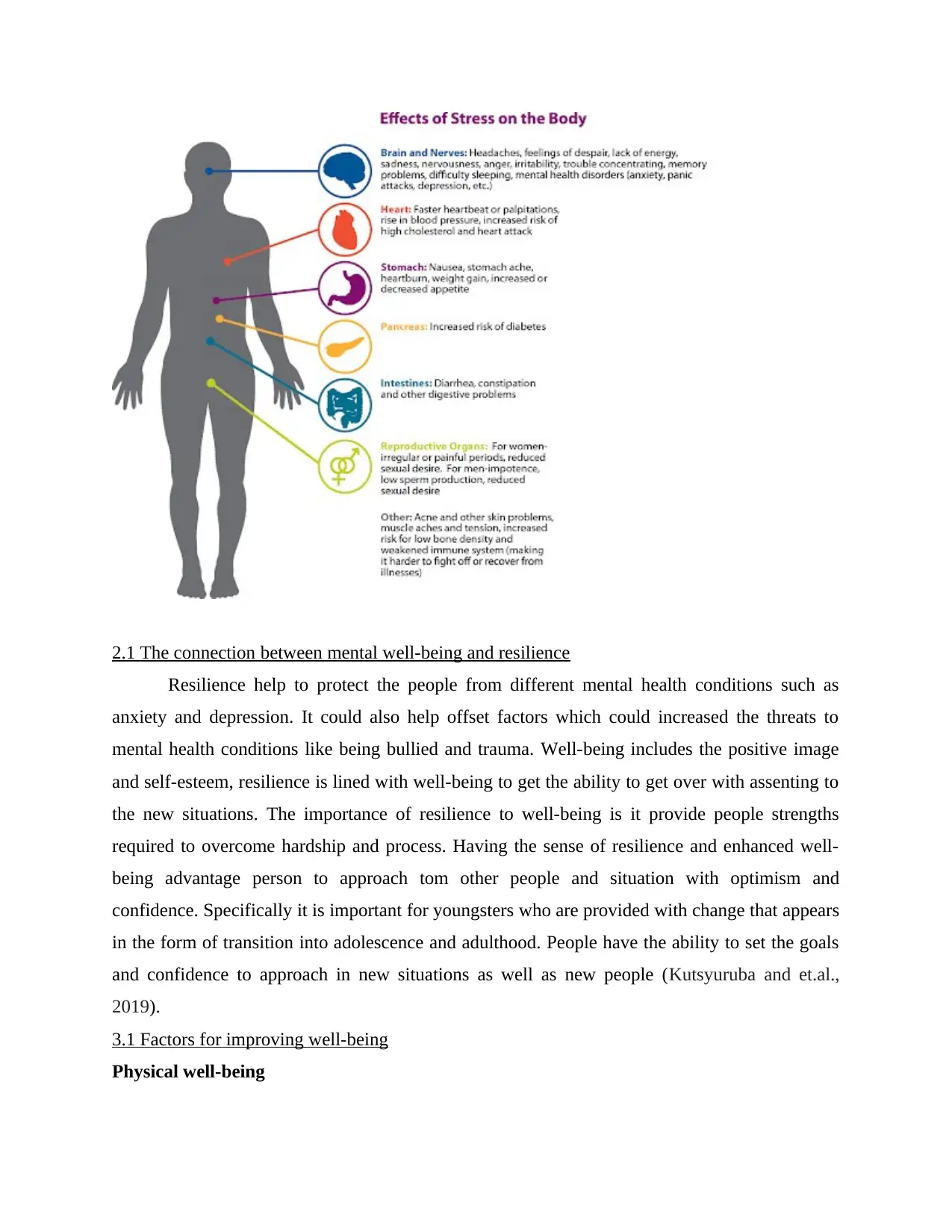
2.1 The connection between mental well-being and resilience
Resilience help to protect the people from different mental health conditions such as
anxiety and depression. It could also help offset factors which could increased the threats to
mental health conditions like being bullied and trauma. Well-being includes the positive image
and self-esteem, resilience is lined with well-being to get the ability to get over with assenting to
the new situations. The importance of resilience to well-being is it provide people strengths
required to overcome hardship and process. Having the sense of resilience and enhanced well-
being advantage person to approach tom other people and situation with optimism and
confidence. Specifically it is important for youngsters who are provided with change that appears
in the form of transition into adolescence and adulthood. People have the ability to set the goals
and confidence to approach in new situations as well as new people (Kutsyuruba and et.al.,
2019).
3.1 Factors for improving well-being
Physical well-being
Resilience help to protect the people from different mental health conditions such as
anxiety and depression. It could also help offset factors which could increased the threats to
mental health conditions like being bullied and trauma. Well-being includes the positive image
and self-esteem, resilience is lined with well-being to get the ability to get over with assenting to
the new situations. The importance of resilience to well-being is it provide people strengths
required to overcome hardship and process. Having the sense of resilience and enhanced well-
being advantage person to approach tom other people and situation with optimism and
confidence. Specifically it is important for youngsters who are provided with change that appears
in the form of transition into adolescence and adulthood. People have the ability to set the goals
and confidence to approach in new situations as well as new people (Kutsyuruba and et.al.,
2019).
3.1 Factors for improving well-being
Physical well-being
Paraphrase This Document
Need a fresh take? Get an instant paraphrase of this document with our AI Paraphraser
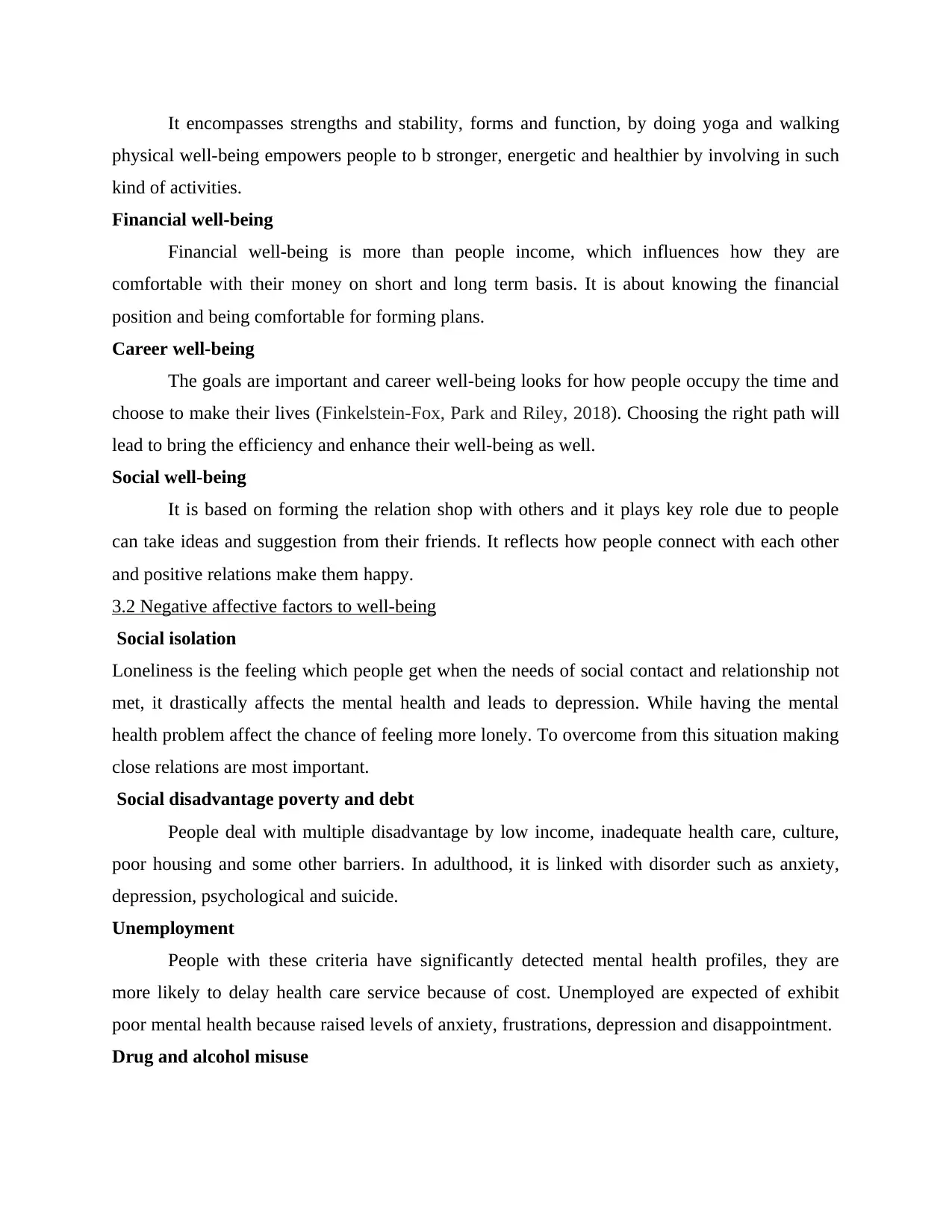
It encompasses strengths and stability, forms and function, by doing yoga and walking
physical well-being empowers people to b stronger, energetic and healthier by involving in such
kind of activities.
Financial well-being
Financial well-being is more than people income, which influences how they are
comfortable with their money on short and long term basis. It is about knowing the financial
position and being comfortable for forming plans.
Career well-being
The goals are important and career well-being looks for how people occupy the time and
choose to make their lives (Finkelstein-Fox, Park and Riley, 2018). Choosing the right path will
lead to bring the efficiency and enhance their well-being as well.
Social well-being
It is based on forming the relation shop with others and it plays key role due to people
can take ideas and suggestion from their friends. It reflects how people connect with each other
and positive relations make them happy.
3.2 Negative affective factors to well-being
Social isolation
Loneliness is the feeling which people get when the needs of social contact and relationship not
met, it drastically affects the mental health and leads to depression. While having the mental
health problem affect the chance of feeling more lonely. To overcome from this situation making
close relations are most important.
Social disadvantage poverty and debt
People deal with multiple disadvantage by low income, inadequate health care, culture,
poor housing and some other barriers. In adulthood, it is linked with disorder such as anxiety,
depression, psychological and suicide.
Unemployment
People with these criteria have significantly detected mental health profiles, they are
more likely to delay health care service because of cost. Unemployed are expected of exhibit
poor mental health because raised levels of anxiety, frustrations, depression and disappointment.
Drug and alcohol misuse
physical well-being empowers people to b stronger, energetic and healthier by involving in such
kind of activities.
Financial well-being
Financial well-being is more than people income, which influences how they are
comfortable with their money on short and long term basis. It is about knowing the financial
position and being comfortable for forming plans.
Career well-being
The goals are important and career well-being looks for how people occupy the time and
choose to make their lives (Finkelstein-Fox, Park and Riley, 2018). Choosing the right path will
lead to bring the efficiency and enhance their well-being as well.
Social well-being
It is based on forming the relation shop with others and it plays key role due to people
can take ideas and suggestion from their friends. It reflects how people connect with each other
and positive relations make them happy.
3.2 Negative affective factors to well-being
Social isolation
Loneliness is the feeling which people get when the needs of social contact and relationship not
met, it drastically affects the mental health and leads to depression. While having the mental
health problem affect the chance of feeling more lonely. To overcome from this situation making
close relations are most important.
Social disadvantage poverty and debt
People deal with multiple disadvantage by low income, inadequate health care, culture,
poor housing and some other barriers. In adulthood, it is linked with disorder such as anxiety,
depression, psychological and suicide.
Unemployment
People with these criteria have significantly detected mental health profiles, they are
more likely to delay health care service because of cost. Unemployed are expected of exhibit
poor mental health because raised levels of anxiety, frustrations, depression and disappointment.
Drug and alcohol misuse
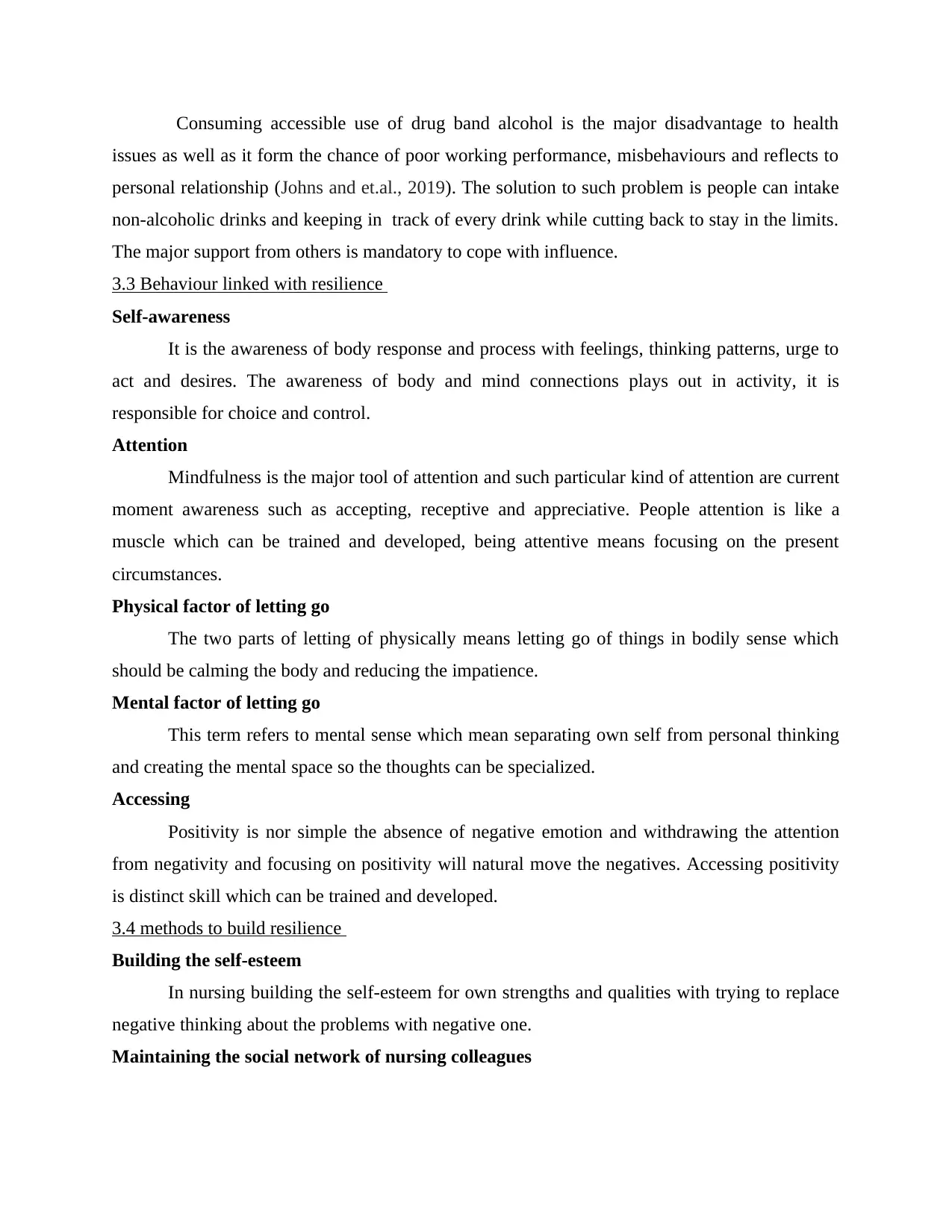
Consuming accessible use of drug band alcohol is the major disadvantage to health
issues as well as it form the chance of poor working performance, misbehaviours and reflects to
personal relationship (Johns and et.al., 2019). The solution to such problem is people can intake
non-alcoholic drinks and keeping in track of every drink while cutting back to stay in the limits.
The major support from others is mandatory to cope with influence.
3.3 Behaviour linked with resilience
Self-awareness
It is the awareness of body response and process with feelings, thinking patterns, urge to
act and desires. The awareness of body and mind connections plays out in activity, it is
responsible for choice and control.
Attention
Mindfulness is the major tool of attention and such particular kind of attention are current
moment awareness such as accepting, receptive and appreciative. People attention is like a
muscle which can be trained and developed, being attentive means focusing on the present
circumstances.
Physical factor of letting go
The two parts of letting of physically means letting go of things in bodily sense which
should be calming the body and reducing the impatience.
Mental factor of letting go
This term refers to mental sense which mean separating own self from personal thinking
and creating the mental space so the thoughts can be specialized.
Accessing
Positivity is nor simple the absence of negative emotion and withdrawing the attention
from negativity and focusing on positivity will natural move the negatives. Accessing positivity
is distinct skill which can be trained and developed.
3.4 methods to build resilience
Building the self-esteem
In nursing building the self-esteem for own strengths and qualities with trying to replace
negative thinking about the problems with negative one.
Maintaining the social network of nursing colleagues
issues as well as it form the chance of poor working performance, misbehaviours and reflects to
personal relationship (Johns and et.al., 2019). The solution to such problem is people can intake
non-alcoholic drinks and keeping in track of every drink while cutting back to stay in the limits.
The major support from others is mandatory to cope with influence.
3.3 Behaviour linked with resilience
Self-awareness
It is the awareness of body response and process with feelings, thinking patterns, urge to
act and desires. The awareness of body and mind connections plays out in activity, it is
responsible for choice and control.
Attention
Mindfulness is the major tool of attention and such particular kind of attention are current
moment awareness such as accepting, receptive and appreciative. People attention is like a
muscle which can be trained and developed, being attentive means focusing on the present
circumstances.
Physical factor of letting go
The two parts of letting of physically means letting go of things in bodily sense which
should be calming the body and reducing the impatience.
Mental factor of letting go
This term refers to mental sense which mean separating own self from personal thinking
and creating the mental space so the thoughts can be specialized.
Accessing
Positivity is nor simple the absence of negative emotion and withdrawing the attention
from negativity and focusing on positivity will natural move the negatives. Accessing positivity
is distinct skill which can be trained and developed.
3.4 methods to build resilience
Building the self-esteem
In nursing building the self-esteem for own strengths and qualities with trying to replace
negative thinking about the problems with negative one.
Maintaining the social network of nursing colleagues
⊘ This is a preview!⊘
Do you want full access?
Subscribe today to unlock all pages.

Trusted by 1+ million students worldwide
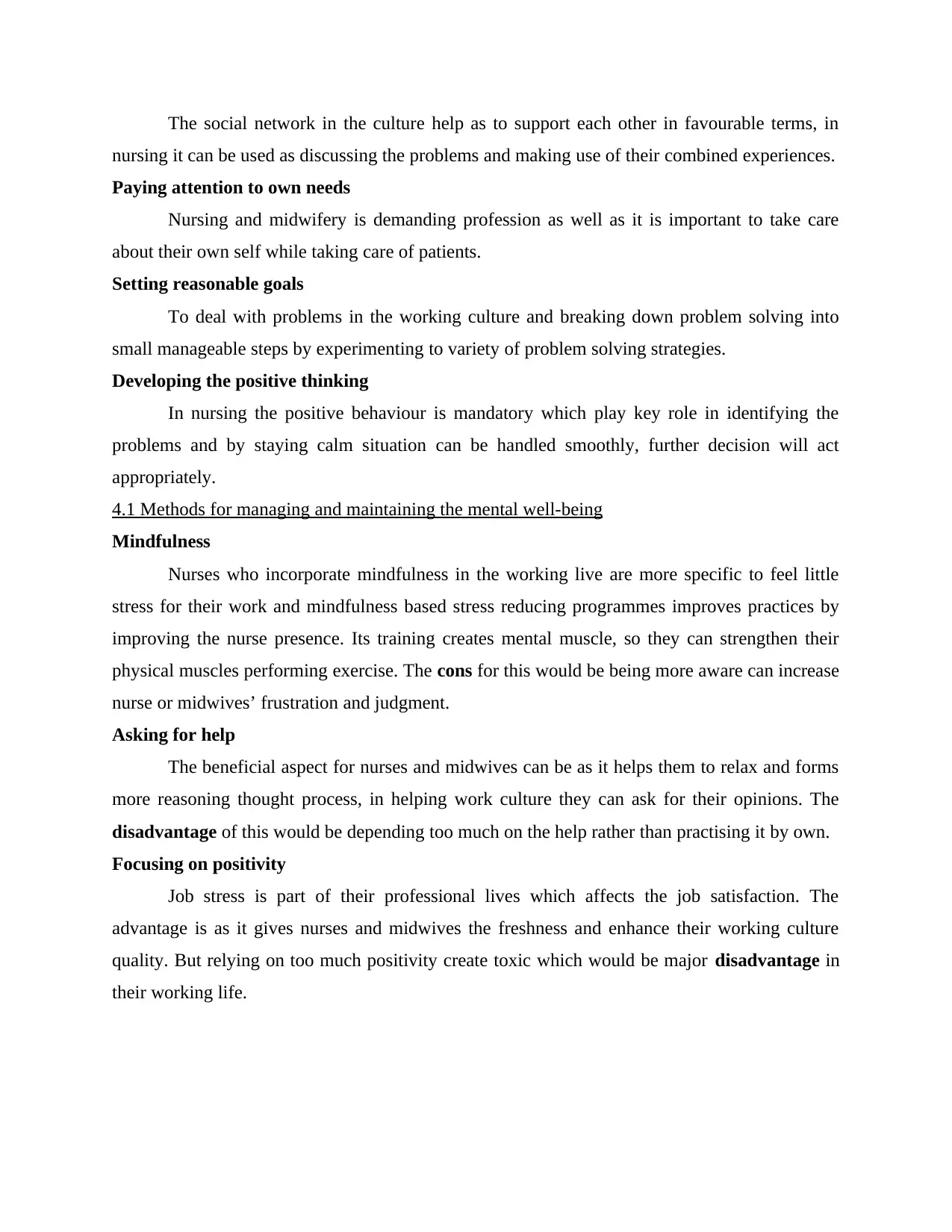
The social network in the culture help as to support each other in favourable terms, in
nursing it can be used as discussing the problems and making use of their combined experiences.
Paying attention to own needs
Nursing and midwifery is demanding profession as well as it is important to take care
about their own self while taking care of patients.
Setting reasonable goals
To deal with problems in the working culture and breaking down problem solving into
small manageable steps by experimenting to variety of problem solving strategies.
Developing the positive thinking
In nursing the positive behaviour is mandatory which play key role in identifying the
problems and by staying calm situation can be handled smoothly, further decision will act
appropriately.
4.1 Methods for managing and maintaining the mental well-being
Mindfulness
Nurses who incorporate mindfulness in the working live are more specific to feel little
stress for their work and mindfulness based stress reducing programmes improves practices by
improving the nurse presence. Its training creates mental muscle, so they can strengthen their
physical muscles performing exercise. The cons for this would be being more aware can increase
nurse or midwives’ frustration and judgment.
Asking for help
The beneficial aspect for nurses and midwives can be as it helps them to relax and forms
more reasoning thought process, in helping work culture they can ask for their opinions. The
disadvantage of this would be depending too much on the help rather than practising it by own.
Focusing on positivity
Job stress is part of their professional lives which affects the job satisfaction. The
advantage is as it gives nurses and midwives the freshness and enhance their working culture
quality. But relying on too much positivity create toxic which would be major disadvantage in
their working life.
nursing it can be used as discussing the problems and making use of their combined experiences.
Paying attention to own needs
Nursing and midwifery is demanding profession as well as it is important to take care
about their own self while taking care of patients.
Setting reasonable goals
To deal with problems in the working culture and breaking down problem solving into
small manageable steps by experimenting to variety of problem solving strategies.
Developing the positive thinking
In nursing the positive behaviour is mandatory which play key role in identifying the
problems and by staying calm situation can be handled smoothly, further decision will act
appropriately.
4.1 Methods for managing and maintaining the mental well-being
Mindfulness
Nurses who incorporate mindfulness in the working live are more specific to feel little
stress for their work and mindfulness based stress reducing programmes improves practices by
improving the nurse presence. Its training creates mental muscle, so they can strengthen their
physical muscles performing exercise. The cons for this would be being more aware can increase
nurse or midwives’ frustration and judgment.
Asking for help
The beneficial aspect for nurses and midwives can be as it helps them to relax and forms
more reasoning thought process, in helping work culture they can ask for their opinions. The
disadvantage of this would be depending too much on the help rather than practising it by own.
Focusing on positivity
Job stress is part of their professional lives which affects the job satisfaction. The
advantage is as it gives nurses and midwives the freshness and enhance their working culture
quality. But relying on too much positivity create toxic which would be major disadvantage in
their working life.
Paraphrase This Document
Need a fresh take? Get an instant paraphrase of this document with our AI Paraphraser
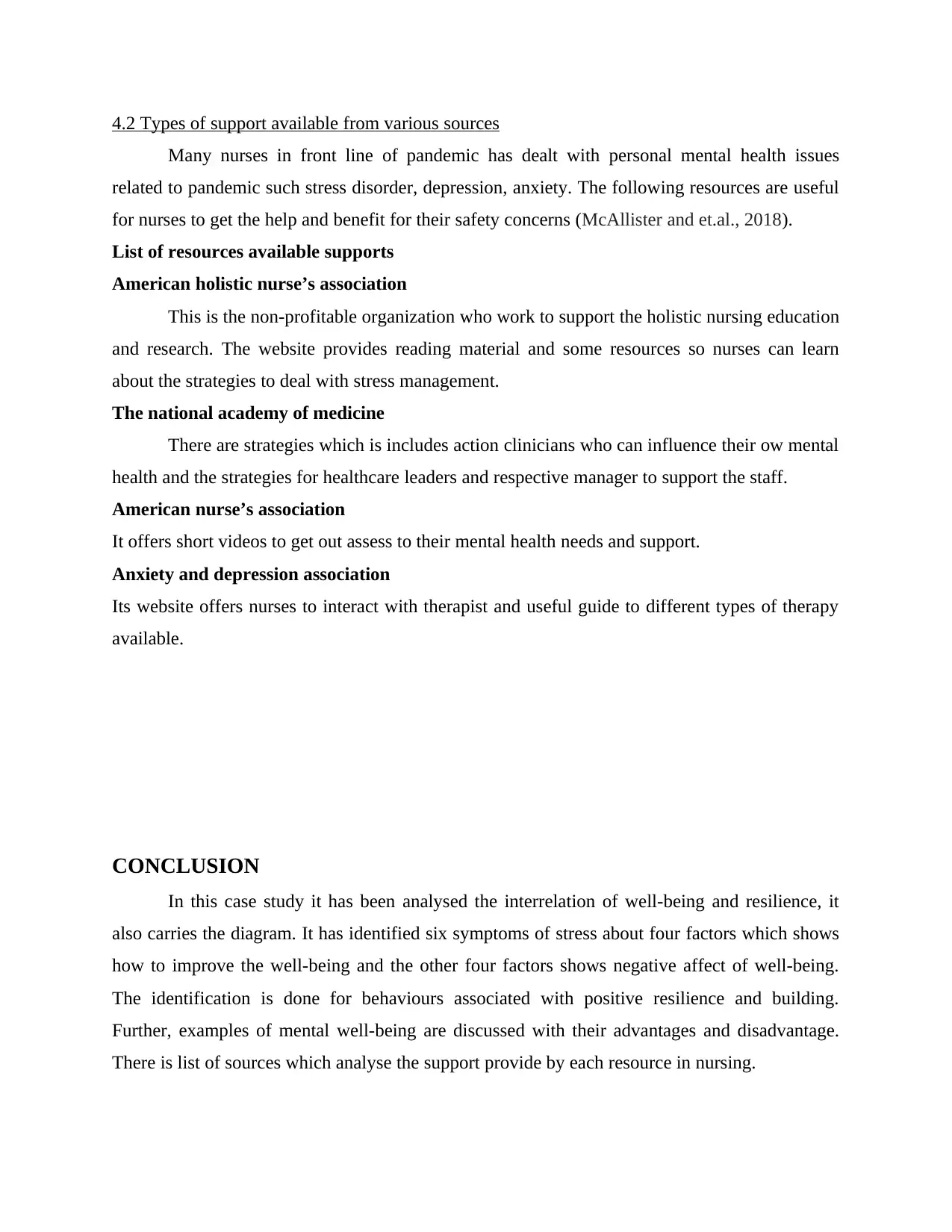
4.2 Types of support available from various sources
Many nurses in front line of pandemic has dealt with personal mental health issues
related to pandemic such stress disorder, depression, anxiety. The following resources are useful
for nurses to get the help and benefit for their safety concerns (McAllister and et.al., 2018).
List of resources available supports
American holistic nurse’s association
This is the non-profitable organization who work to support the holistic nursing education
and research. The website provides reading material and some resources so nurses can learn
about the strategies to deal with stress management.
The national academy of medicine
There are strategies which is includes action clinicians who can influence their ow mental
health and the strategies for healthcare leaders and respective manager to support the staff.
American nurse’s association
It offers short videos to get out assess to their mental health needs and support.
Anxiety and depression association
Its website offers nurses to interact with therapist and useful guide to different types of therapy
available.
CONCLUSION
In this case study it has been analysed the interrelation of well-being and resilience, it
also carries the diagram. It has identified six symptoms of stress about four factors which shows
how to improve the well-being and the other four factors shows negative affect of well-being.
The identification is done for behaviours associated with positive resilience and building.
Further, examples of mental well-being are discussed with their advantages and disadvantage.
There is list of sources which analyse the support provide by each resource in nursing.
Many nurses in front line of pandemic has dealt with personal mental health issues
related to pandemic such stress disorder, depression, anxiety. The following resources are useful
for nurses to get the help and benefit for their safety concerns (McAllister and et.al., 2018).
List of resources available supports
American holistic nurse’s association
This is the non-profitable organization who work to support the holistic nursing education
and research. The website provides reading material and some resources so nurses can learn
about the strategies to deal with stress management.
The national academy of medicine
There are strategies which is includes action clinicians who can influence their ow mental
health and the strategies for healthcare leaders and respective manager to support the staff.
American nurse’s association
It offers short videos to get out assess to their mental health needs and support.
Anxiety and depression association
Its website offers nurses to interact with therapist and useful guide to different types of therapy
available.
CONCLUSION
In this case study it has been analysed the interrelation of well-being and resilience, it
also carries the diagram. It has identified six symptoms of stress about four factors which shows
how to improve the well-being and the other four factors shows negative affect of well-being.
The identification is done for behaviours associated with positive resilience and building.
Further, examples of mental well-being are discussed with their advantages and disadvantage.
There is list of sources which analyse the support provide by each resource in nursing.

⊘ This is a preview!⊘
Do you want full access?
Subscribe today to unlock all pages.

Trusted by 1+ million students worldwide
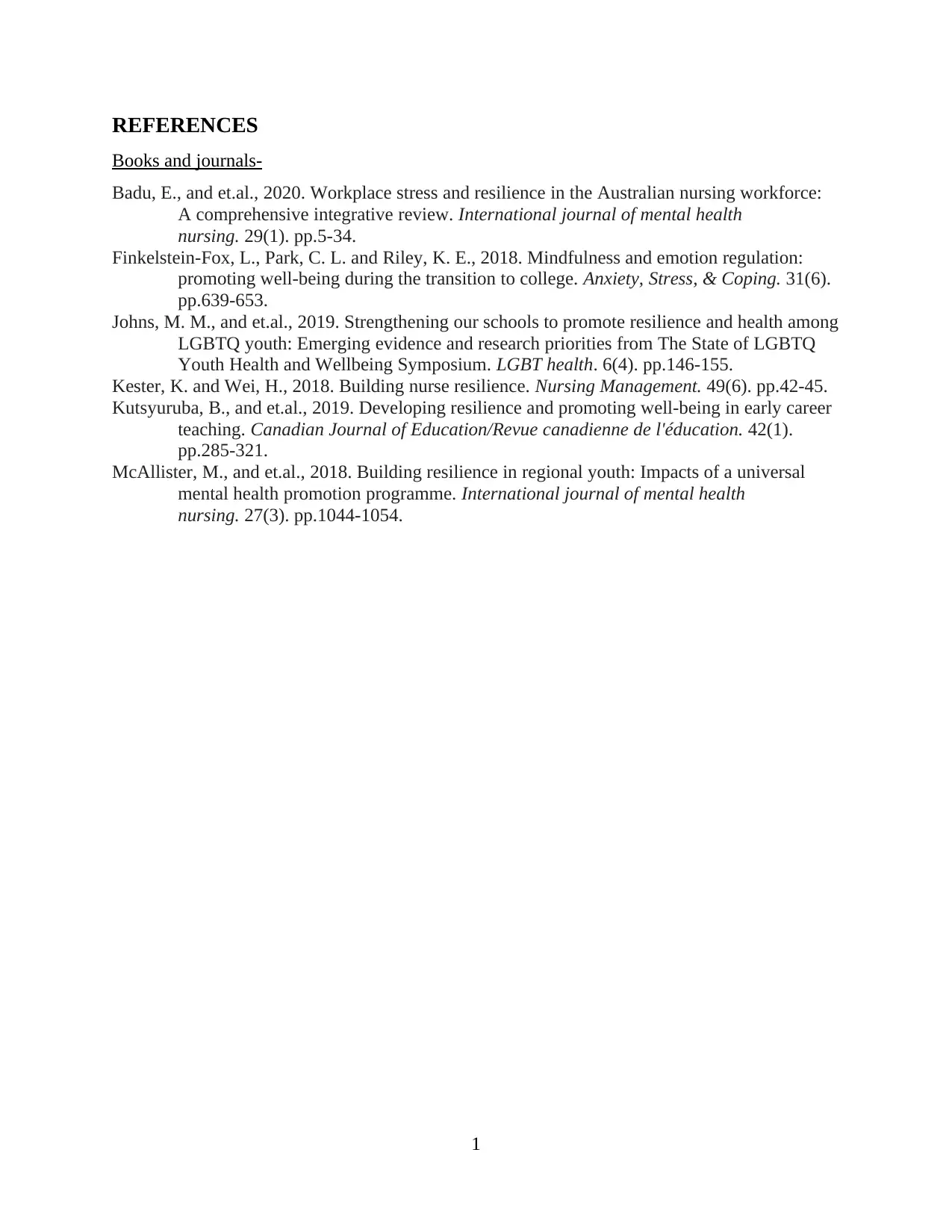
REFERENCES
Books and journals-
Badu, E., and et.al., 2020. Workplace stress and resilience in the Australian nursing workforce:
A comprehensive integrative review. International journal of mental health
nursing. 29(1). pp.5-34.
Finkelstein-Fox, L., Park, C. L. and Riley, K. E., 2018. Mindfulness and emotion regulation:
promoting well-being during the transition to college. Anxiety, Stress, & Coping. 31(6).
pp.639-653.
Johns, M. M., and et.al., 2019. Strengthening our schools to promote resilience and health among
LGBTQ youth: Emerging evidence and research priorities from The State of LGBTQ
Youth Health and Wellbeing Symposium. LGBT health. 6(4). pp.146-155.
Kester, K. and Wei, H., 2018. Building nurse resilience. Nursing Management. 49(6). pp.42-45.
Kutsyuruba, B., and et.al., 2019. Developing resilience and promoting well-being in early career
teaching. Canadian Journal of Education/Revue canadienne de l'éducation. 42(1).
pp.285-321.
McAllister, M., and et.al., 2018. Building resilience in regional youth: Impacts of a universal
mental health promotion programme. International journal of mental health
nursing. 27(3). pp.1044-1054.
1
Books and journals-
Badu, E., and et.al., 2020. Workplace stress and resilience in the Australian nursing workforce:
A comprehensive integrative review. International journal of mental health
nursing. 29(1). pp.5-34.
Finkelstein-Fox, L., Park, C. L. and Riley, K. E., 2018. Mindfulness and emotion regulation:
promoting well-being during the transition to college. Anxiety, Stress, & Coping. 31(6).
pp.639-653.
Johns, M. M., and et.al., 2019. Strengthening our schools to promote resilience and health among
LGBTQ youth: Emerging evidence and research priorities from The State of LGBTQ
Youth Health and Wellbeing Symposium. LGBT health. 6(4). pp.146-155.
Kester, K. and Wei, H., 2018. Building nurse resilience. Nursing Management. 49(6). pp.42-45.
Kutsyuruba, B., and et.al., 2019. Developing resilience and promoting well-being in early career
teaching. Canadian Journal of Education/Revue canadienne de l'éducation. 42(1).
pp.285-321.
McAllister, M., and et.al., 2018. Building resilience in regional youth: Impacts of a universal
mental health promotion programme. International journal of mental health
nursing. 27(3). pp.1044-1054.
1
1 out of 10
Related Documents
Your All-in-One AI-Powered Toolkit for Academic Success.
+13062052269
info@desklib.com
Available 24*7 on WhatsApp / Email
![[object Object]](/_next/static/media/star-bottom.7253800d.svg)
Unlock your academic potential
© 2024 | Zucol Services PVT LTD | All rights reserved.





